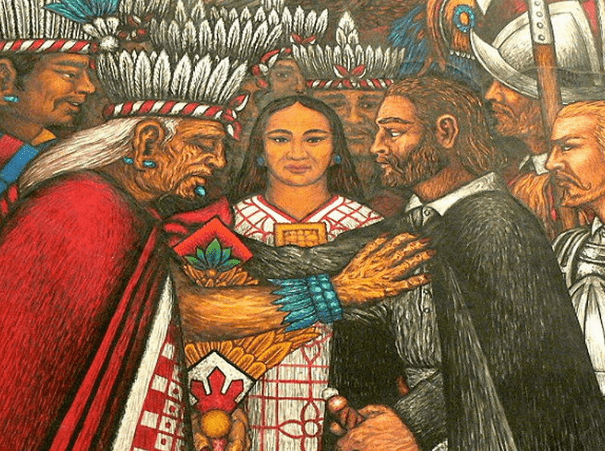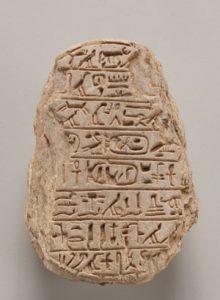Winner of the Fall 2016 StMU History Media Award for
Best Article in the Category of “People”
Best Article in the Category of “World History”
Largely due to the importation of disease and use of superior weapons, the Spaniards were able to conquer the Aztec capital of Tenochtitlan, kill the empire’s last emperor, Cuauhtémoc, and bring the Aztec empire to an end. Few know of La Malinche, the indigenous interpreter of Hernán Cortés, whose linguistic abilities were used to facilitate important conversations between the Spaniards and the indigenous leaders. Without the help of La Malinche, perhaps the Aztec empire would have survived.
Born between 1502 and 1505, La Malinche was named Malinalli Tenepal, the first part of her name being a Nahuatl term for the twelfth day of the month in correspondence to the Aztec calendar, and the second part of her name meaning “lively.” She was born of nobility in Paynala within the region of Veracruz. Her troubles started at a young age after the death of her father. La Malinche was ousted from her home to ensure her new half-brother received the inheritance of the family instead of her, since she was the eldest child. She was given to “some Indians of Xicalango.”1 Then the Indians gave her to a nobleman in Tobasco, a region in the Yucatan. When Cortés arrived to Tobasco, he was offered twenty slaves, one of them being La Malinche. Having lived in Veracruz, a Nahuatl-speaking region, and then being sold into a Maya-speaking region, La Malinche knew both languages and she was soon recognized for the linguistic talents that could benefit Cortés in his conquests.2

The few glimpses of La Malinche and how her presence as an interpreter accelerated the fall of the Aztec empire can be found in the writings of the Spanish explorers, specifically from Hernán Cortés, her “lord and master.”3 From the second letter Hernán Cortés wrote to Emperor Charles V, dated October 30, 1530, Cortés speaks of La Malinche as “a female interpreter that I had, who was a native of this country, and whom I obtained at Putunchún on the Rio Grande.”4 This confirms the vague aspects of her life that we already know. But most importantly, in this context, this letter goes on to tell of a scenario in which La Malinche saved the Spaniards from an ambush by the Cholulans. La Malinche was told by the wife of a native leader that they planned to attack the Spaniards and if La Malinche came with them, she would be protected. La Malinche delivered this message to Cortés, which ultimately led to the massacre of Cholula and provided a direct path to march towards Tenochitlan, the capital of the Aztec empire.5 This leads to the question of whether or not La Malinche was a traitor or a survivor. Did she explicitly want the Aztec empire to fall or did she just want to save herself from the carnage?
With no traces of primary sources from La Malinche herself, her story has been retold by various scholars without much consistency, nothing ever being certain. Up until the twentieth century, La Malinche was viewed as a traitor to her country Mexico. In 1861, on the celebration day of Mexico’s Independence, Ignacio “El Nigromante” Ramírez, a Mexican journalist, addressed the Mexican people by saying, “One of the mysteries of fate is that every Mexican owes his downfall and disgrace to a woman, and to another woman his salvation and glory; the myth of Eve and Mary is reproduced everywhere; we indignantly remember Cortés’s mistress and will never forget, in our gratitude to Doña María Josefa Ortiz.”6 La Malinche is seen as playing a key role in the subjugation of the Mexican peoples to Spain, while Doña María Josefa Ortiz did the contrary and liberated the country. However, many Chicana writers and modern scholars are trying to rewrite the tale of La Malinche to understand the complexities of her choices and to vindicate her. For example, Gloria Anzaldua promotes the idea that La Malinche had a “new consciousness,” that she voluntarily served as the interpreter of Cortés not only to save herself, but also because she knew that a new mestiza culture was going to be born (especially considering she had a son with Cortés in 1524).7 She made a conscious effort to exchange language and cultural aspects from each side in order to facilitate the emergence of the new mestiza society; however, with that came brutal consequences in the shape of warfare and mass death in the New World.
Whether or not La Malinche’s role as Cortés’s interpreter was traitorous, simply an effort to survive, or some other complex reason involving love for Cortés, hate for the Aztec empire for the cruelty she faced after being ousted from her home, or promotion of the new mestiza culture, no one will ever know the true story of the Indian, slave woman who traveled alongside Cortés towards the culmination of the Aztec empire.
- Bernal Castillo del Díaz, The Discovery and Conquest of Mexico, 1517-1521 rev. American ed., trans. A.P. Maudsley (New York: The Noonday Press, 1965), chap. 22-23. ↵
- Pilar Godayol, “Malintzin/ La Malinche/ Doña Marina: re-reading the myth of the treacherous translator,” Journal of Iberian and Latin American Studies 18, no. 1 (April 2012): 61-68. ↵
- Castillo del Bernal, chap 23. ↵
- Hernan Cortes to Emperor Charles V, October 30, 1520, in Letters of Despatches of Hernando Cortes, to the Emperor Charles V., trans. (New York: Wiley and Putnam, 1843), letter II. ↵
- Hernan Cortes to Emperor Charles V, October 30, 1520, in Letters of Despatches of Hernando Cortes, to the Emperor Charles V, letter II. ↵
- Rosario Pérez-Lagunes, “The Myth of La Malinche: From the Chronicles to Modern Mexican Theater” (PhD dis., Virginia Polytechnic Institute and State University, 2001), 24. Although she was of Spanish descent, Doña María Josefa Ortiz was born in Valladolid, Mexico in 1768 and identified herself as Mexican. She and her husband were both a part of the rebellion that ultimately led to Mexico’s independence from Spain in 1824. ↵
- Godayol, 68-70. ↵



230 comments
Marissa Gonzalez
I have heard of “La Malinche”, however, I was not too familiar with the background of this story. I feel as if this article gives another perspective that does not give off a negative viewpoint of La Malinche. It may be because when there is a popular opinion on something, people tend to talk about it more rather than the full story. I think you did a great job on trying to show the unfamiliar side of La Malinche and give a reason to why she may have been portrayed as a traitor. This was an engaging article. Great job!
Luke Trevino
The article was correct not a lot of people know if this amazing women including myself! I believe she did what she had to in order to survive but I also believe she was loyal to her work. I believe she loved what she did because she was probably treated better then how she was when she was ousted from her home! Overall, very well written and explained article!
Aimee Trevino
Great article! I had heard of “La Malinche”, but always in a negative way, so I always saw her as a traitor to her own people. After reading this article, however, I guess I can see how maybe other factors could come into play, such as her being outsed by the Aztec, or possibly lover for Hernan Cortes. Either way, it is interesting to see a different perspective.
Zaraly Frasquillo
I chose this article because a couple of days ago I was reading about her, and when I first read about her I tried to put myself in her position. Although she was treated horribly by the Aztecs, I see her as a traitor. I really don’t know if it is because I am a prideful Mexican, but I see her as part of the reason why the Aztec Empire fell. But, I applaud you, this is a great article, it’s a very controversial topic but you did an amazing job.
Bailey Rider
Just last semester in my Civilizations class, we learned about Malinche, and I saw her as a traitor to Mexico. However, after this article, I can see both sides now. I’m still not sure about whether she was just trying to survive but I could understand it if she was. It was interesting to learn about her family life and how she was thrown out of her house and then taken as a slave. I could see how that might harbor some hard feelings. It was also cool to learn about how Chinese writers and modern scholars have been working to exonerate her. Thank you for this article!
Gabriela Medrano
I chose this article because just by the title it gave it an intriguing pull for debate. Firstly, I have no recollection of this woman, not anywhere in Latin history so thank you for bringing her out into the light. The context was full of insight! Cortes bearing a child with the woman was a strange fact. However, the article was a bit bias. I feel you have drawn her out as more of a traitor than a survivor and played more with that role rather than create sympathy for her being a survivor. Given that you leave the reader at a mystery and allow us to create or own opinion, I would rather read on both sides evenly to create more of a debate. Overall, well written and great topic!
Ana Gonzalez
I have always heard of la Malinche being described as a traitor because she helped translate for Cortes and this facilitated the Spaniards conquest. In my understanding she did not protect her people and instead she betrayed them by helping the enemies. This article was interesting because it opened my eyes to a whole other perspective on the Malinche because I now understand that she might have been doing what was best for her. Perhaps she felt that the Aztec civilization was doomed so she decided to help Cortes build a new culture. This article was well-written and it provides great insight to who la Malinche really was.
Gabriela Serrato
I was thrilled to read this article and find the many similarities it has in comparison to Kurt Vonnegut’s “Mother Night.” While in Vonnegut’s novel, Howard is a Nazi propagandist who is encoding his messages to give America the upper hand. But when WWII ended, his true identity of being a spy was nearly impossible to prove so he almost faced death for his crimes as being a part of the Nazi regime. This reminded me of La Malinche because she too was believed to be a traitor. But with so many unknowns, especially being in that time period, it is hard to say if she was an actual traitor, was simply looking out for her own well being, or truly had good intentions just as Howard did in Vonnegut’s novel.
Erik Rodriguez
Great article! I’ve heard this story many times before and I believe that she was not truly aware of the threat against her people. I feel she was trying to save herself, which is completely understandable. I imagine she felt great sorrow once she realized she helped the “bad guys.” Many believe she was a traitor, but if it wasn’t her, it would’ve been someone else. She was just doing what she had to do in order to survive.
Very informative and well written article!
Esperanza Mauricio
History always has two sides. This is no exception. I quite like how many now are trying to change the story’s negative view of her choices. Understanding the context in which such choices were made may help many to understand La Malinche. Changing the negative view of her story.